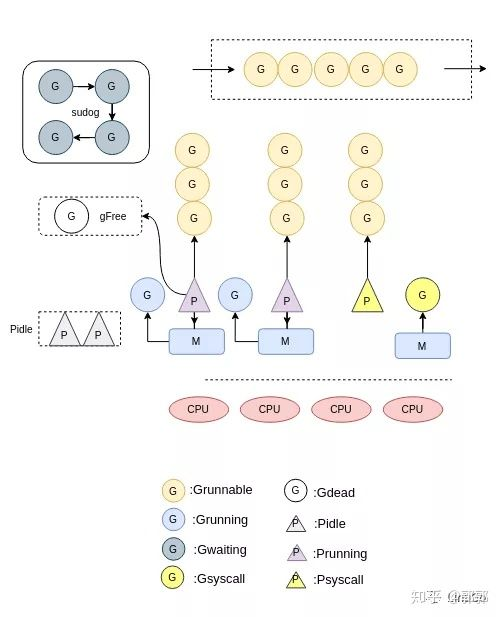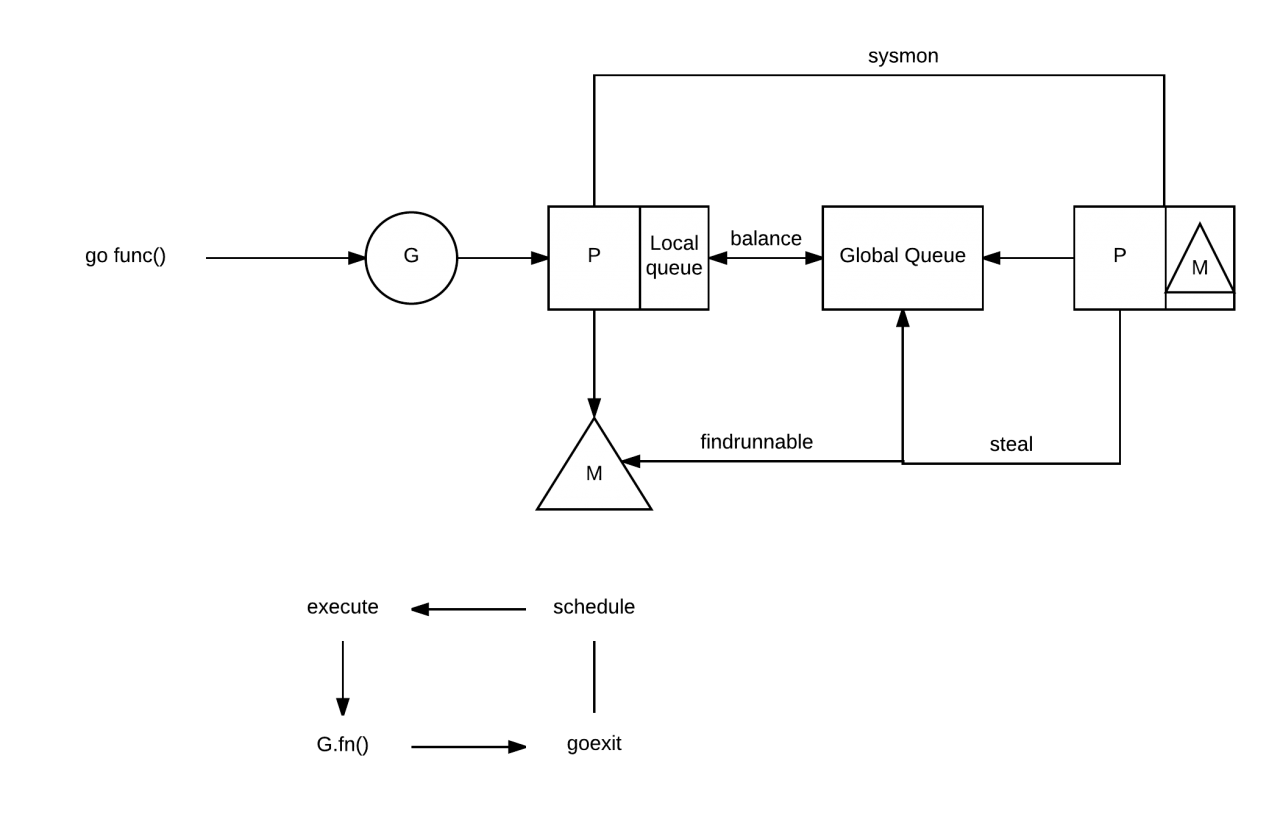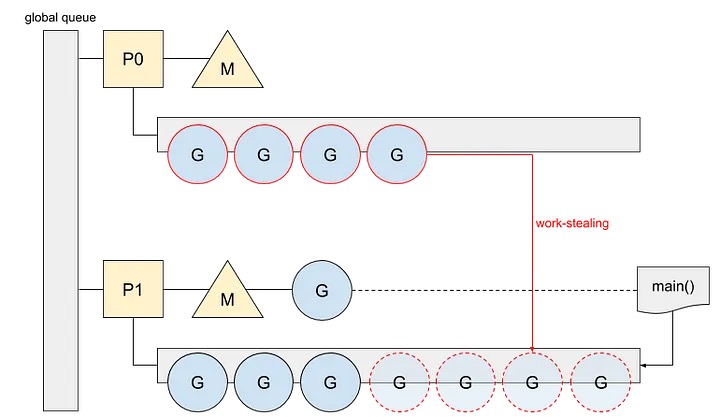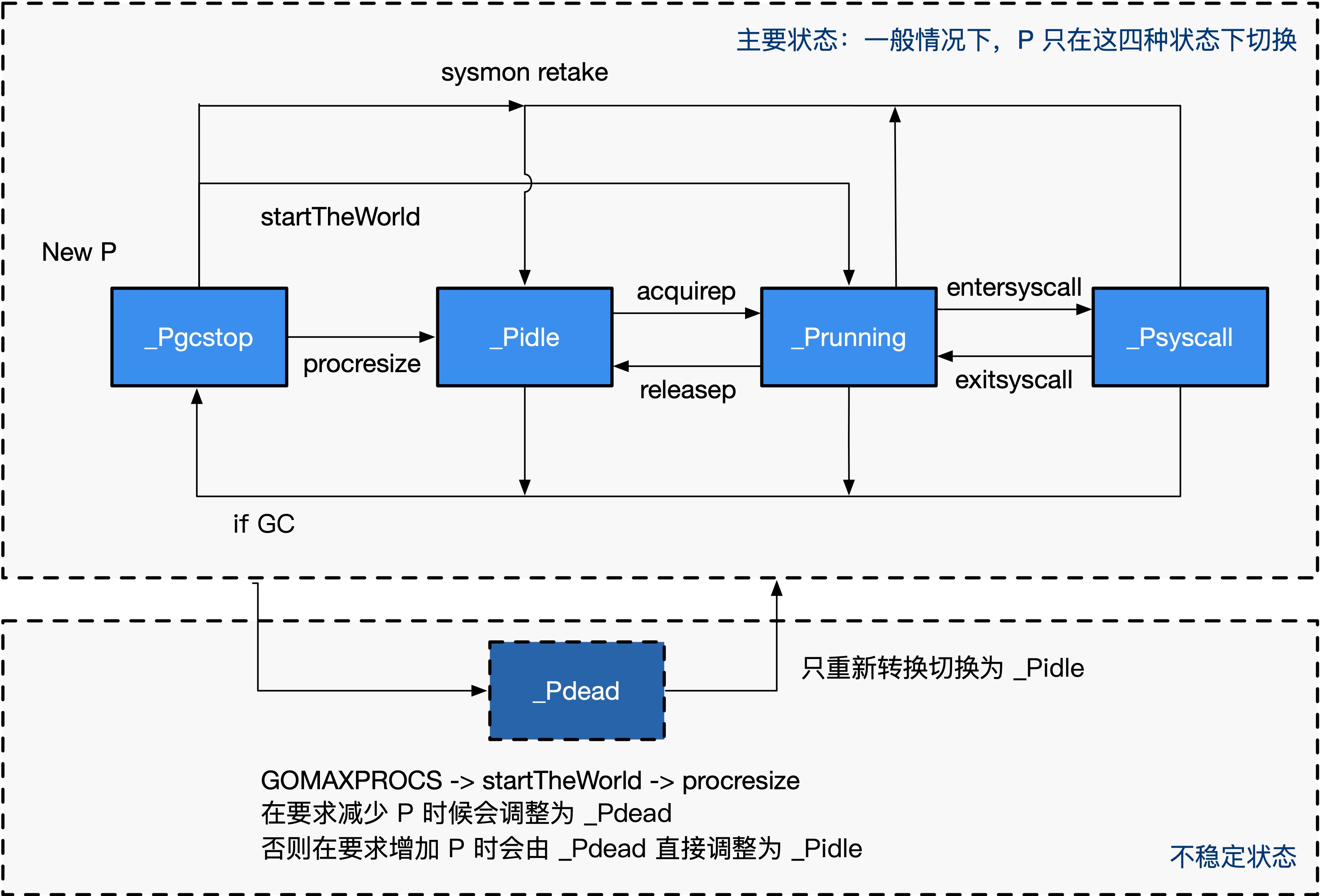详尽干货!从源码角度看 Golang 的调度
调度器
详尽干货!从源码角度看 Golang 的调度(上)
Getting Started With Golang Channels! Here’s Everything You Need to Know
深入golang runtime的调度
code
Go: What Does a Goroutine Switch Actually Involve?
Go: How Does the Goroutine Stack Size Evolve?
MPG 模型与并发调度单元
Illustrated Tales of Go Runtime Scheduler.
Go调度器系列(3)图解调度原理
Go netpoller 原生网络模型之源码全面揭秘
图解Go运行时调度器
Go 运行程序中的线程数
Go中的调度器(4)–goroutine状态转移
Go 程序启动过程是怎样的
GMP
【深入理解Go】协程设计与调度原理(上)
Go 为什么这么“快”
Golang三关-典藏版 Golang 调度器 GMP 原理与调度全分析
How Goroutines Work - https://blog.nindalf.com/posts/how-goroutines-work/
go runtime - go程序启动过程
Go: g0, Special Goroutine
sysmon 后台监控线程做了什么 - 码农桃花源
Go中定时器实现原理及源码解析


G-M-P Components
what:
- go实现的调度
- run in user space
- 更加高效
role:
- g: 用户线程, 包含等待被执行的function code
- processor: connector, 连接 machine 和 g
- machine: 真正执行代码的实体 , 关联一个系统线程,通过系统线程执行
m:n modal: 多个用户线程复用一个系统线程
pros:
- less create cost: 创建少数的kernel thread进行复用, 创建大量廉价的g;
- less context switch: most context switch in user space
8888888888888888888888888
more effective:
- m:n modal, less create and context switch cost
- cooperation modal: less context switch time
the count:
g: 创建成本主要是stack size 2kb , plus some small overhead for control block(g struct) , 1GB= 5millon g
processor: max = the number of cpu
1
|
runtime.GOMAXPROCS(runtime.NumCPU())
|
machine count:
max running machine = processor count;
why go scheduler is good for concurrecy :
- 降低线程使用的开始: 线程很轻量,可以无限制的创建
- 原生支持csp, 对程序员而言更容易实现复杂的并发
- 消除并发常见的问题: data-race, dead-lock
- 以模块化的方式实现并发
- 更容易实现复杂并发: 将复杂问题分解成小模块
- 更容易维护: 1. 发现和调式问题 2.修改
模块化方式:
每个g 是一个模块,是一个独立的个体,与其他模块通过channel 连接
processor
-
state:
 stop->idle<->running<->systemcall
stop->idle<->running<->systemcall
-
code
1
2
3
4
5
6
7
8
9
10
11
12
13
14
15
16
17
18
19
20
21
22
23
|
type p struct {
id int32
status uint32 // p 的状态 pidle/prunning/...
link puintptr
m muintptr // 反向链接到关联的 m (nil 则表示 idle)
mcache *mcache
pcache pageCache
deferpool [5][]*_defer // 不同大小的可用的 defer 结构池
deferpoolbuf [5][32]*_defer
runqhead uint32 // 可运行的 Goroutine 队列,可无锁访问
runqtail uint32
runq [256]guintptr
runnext guintptr
timersLock mutex
timers []*timer
preempt bool
// Available G's (status == Gdead)
gFree struct {
gList
n int32
}
}
|
why need processor:
- cache localqueue g, reduce global locker contention
- decouple machine and goroutine, then can help:
- machine 生命周期不影响 local queue
- 不需要创建更多的os thread
machine and goroutine的中介
- 缓存goroutine: machine 无锁访问
为什么不使用machine 缓存gorotine:
machine 可能 系统调用停止运行
machine
-
what?
- 执行实体: run a loop
-
绑定一条 os thread, 通过 os thread 执行
-
structure
1
2
3
4
5
6
7
8
9
10
11
12
13
14
|
// src/runtime/runtime2.go
type m struct {
g0 *g // 用于执行调度指令的 Goroutine
gsignal *g // 处理 signal 的 g
tls [6]uintptr // 线程本地存储
curg *g // 当前运行的用户 Goroutine
p puintptr // 执行 go 代码时持有的 p (如果没有执行则为 nil)
spinning bool // m 当前没有运行 work 且正处于寻找 work 的活跃状态
cgoCallers *cgoCallers // cgo 调用崩溃的 cgo 回溯
alllink *m // 在 allm 上
mcache *mcache
...
}
|
-
new machine
- alloc machine;
- alloc os thread;
1
2
3
4
5
6
7
8
9
10
11
12
13
14
15
16
17
18
19
20
21
22
23
24
25
26
27
28
29
30
31
32
33
34
35
36
37
38
39
40
41
42
|
// Create a new m. It will start off with a call to fn, or else the scheduler.
// fn needs to be static and not a heap allocated closure.
// May run with m.p==nil, so write barriers are not allowed.
//go:nowritebarrierrec
// 创建一个新的m,它将从fn或者调度程序开始
// fn需要是静态的,而不是堆分配的闭包。
func newm(fn func(), _p_ *p) {
// 根据fn和p和绑定一个m对象
mp := allocm(_p_, fn)
// 设置当前m的下一个p为_p_
mp.nextp.set(_p_)
mp.sigmask = initSigmask
if gp := getg(); gp != nil && gp.m != nil && (gp.m.lockedExt != 0 || gp.m.incgo) && GOOS != "plan9" {
// 我们处于锁定的M或可能由C启动的线程。此线程的内核状态可能很奇怪(用户可能已将其锁定为此目的)。
// 我们不想将其克隆到另一个线程中。相反,请求一个已知良好的线程为我们创建线程。
lock(&newmHandoff.lock)
if newmHandoff.haveTemplateThread == 0 {
throw("on a locked thread with no template thread")
}
mp.schedlink = newmHandoff.newm
newmHandoff.newm.set(mp)
if newmHandoff.waiting {
newmHandoff.waiting = false
notewakeup(&newmHandoff.wake)
}
unlock(&newmHandoff.lock)
return
}
// 真正的分配os thread
newm1(mp)
}
func newm1(mp *m) {
// 对cgo的处理
...
execLock.rlock() // Prevent process clone.
// 创建一个系统线程,并且传入该 mp 绑定的 g0 的栈顶指针
// 让系统线程执行 mstart 函数,后面的逻辑都在 mstart 函数中
newosproc(mp, unsafe.Pointer(mp.g0.stack.hi))
execLock.runlock()
}
|
-
state
1
2
3
4
5
6
7
8
9
10
|
mstart
|
v
+--------+ 找不到可执行任务 +-------+
|unspinin| ----------------------------> |spining|
| | <---------------------------- | |
+--------+ 找到可执行任务 +-------+
^ | stopm
| wakep v
notewakeup <------------------------- notesleep
|
-
work:
-
unsping:
-
spinning: steal
-
waiting:
- sleeping: not find g;
- systemcall
-
is machine count limit?
-
limit the active machine count
-
if the i/o increase, the machine count increase
goroutine
structure:
gobuf: register info, used for context switch
stack: 当前 g使用的stack;
stauts: g status
m: 对应的线程
1
2
3
4
5
6
7
8
9
10
11
12
13
14
15
16
17
18
19
20
21
22
23
24
25
26
27
28
29
30
31
32
33
34
35
36
|
type g struct {
// 当前 Goroutine 的栈内存范围 [stack.lo, stack.hi)
stack stack
// 用于调度器抢占式调度
stackguard0 uintptr
goid int64
_panic *_panic
_defer *_defer
// 当前 Goroutine 占用的线程
m *m
// 存储 Goroutine 的调度相关的数据
sched gobuf
// Goroutine 的状态
atomicstatus uint32
// 抢占信号
preempt bool // preemption signal, duplicates stackguard0 = stackpreempt
// 抢占时将状态修改成 `_Gpreempted`
preemptStop bool // transition to _Gpreempted on preemption; otherwise, just deschedule
// 在同步安全点收缩栈
preemptShrink bool // shrink stack at synchronous safe point
...
}
type gobuf struct {
// 栈指针
sp uintptr
// 程序计数器
pc uintptr
// gobuf对应的Goroutine
g guintptr
// 系统调用的返回值
ret sys.Uintreg
...
}
|
status:
- prepare: idle-> runnable
- run: running
- block:
- waiting
- syscall


process vs thread vs go-routine:
same:
- 实现并发的组件
- 独立的可执行代码/路径
differ: more lightweight
- thread: 共享process’s memory
- go-routines: 共享(多路复用 ) thread’s time
cheaper:
- less memory cost:dynamic stack,2kb
- less cpu time: create and switch in user space, not need kernel involvement
not expose go id:
- 暴露id 会让开发者基于id(共享变量方式) 实现线程通信, 这不符合go的哲学
g0: Do scheduling work
feature:
fixed and larger size, 2MB, 在执行特殊任务需要更大空间
max g:
2kb=2KB *1000* 1000 = 1million* 2
schedule
code
1
2
3
4
5
6
7
8
9
10
11
12
13
14
15
16
17
18
19
20
21
22
23
24
25
26
27
28
29
30
31
32
33
34
35
36
37
38
39
40
41
42
43
44
45
46
47
48
49
50
51
52
53
54
55
56
57
58
59
60
61
62
63
64
65
66
67
68
69
70
71
72
73
74
75
76
77
78
79
80
81
82
83
84
85
86
87
88
89
90
91
92
93
94
95
96
97
98
99
100
101
102
103
104
105
106
107
108
109
110
111
112
113
114
115
116
117
118
119
120
121
122
123
124
125
126
127
128
129
130
131
132
133
134
135
136
137
138
139
140
141
142
143
144
145
146
147
148
149
150
151
152
153
154
155
156
157
158
159
160
161
162
163
164
165
166
167
168
169
170
171
172
173
174
175
176
177
178
179
180
181
182
183
184
185
186
187
188
189
190
191
192
193
194
195
196
197
198
199
200
201
202
203
204
205
206
207
208
209
|
// Finds a runnable goroutine to execute.
// Tries to steal from other P's, get g from global queue, poll network.
// 找到一个可以运行的G,不找到就让M休眠,然后等待唤醒,直到找到一个G返回
func findrunnable() (gp *g, inheritTime bool) {
_g_ := getg()
// 此处和handoffp中的条件必须一致:如果findrunnable将返回G运行,则handoffp必须启动M.
top:
// 当前m绑定的p
_p_ := _g_.m.p.ptr()
...
// local runq
// 再尝试从本地队列中获取G
if gp, inheritTime := runqget(_p_); gp != nil {
return gp, inheritTime
}
// global runq
// 尝试从全局队列中获取G
if sched.runqsize != 0 {
lock(&sched.lock)
gp := globrunqget(_p_, 0)
unlock(&sched.lock)
if gp != nil {
return gp, false
}
}
// 从网络IO轮询器中找到就绪的G,把这个G变为可运行的G
if netpollinited() && atomic.Load(&netpollWaiters) > 0 && atomic.Load64(&sched.lastpoll) != 0 {
if gp := netpoll(false); gp != nil { // non-blocking
// netpoll returns list of goroutines linked by schedlink.
// 如果找到的可运行的网络IO的G列表,则把相关的G插入全局队列
injectglist(gp.schedlink.ptr())
// 更改G的状态为_Grunnable,以便下次M能找到这些G来执行
casgstatus(gp, _Gwaiting, _Grunnable)
// goroutine trace事件记录-unpark
if trace.enabled {
traceGoUnpark(gp, 0)
}
return gp, false
}
}
// Steal work from other P's.
procs := uint32(gomaxprocs)
// 如果其他P都是空闲的,就不从其他P哪里偷取G了
if atomic.Load(&sched.npidle) == procs-1 {
// Either GOMAXPROCS=1 or everybody, except for us, is idle already.
// New work can appear from returning syscall/cgocall, network or timers.
// Neither of that submits to local run queues, so no point in stealing.
goto stop
}
// 如果当前的M没在自旋 且 空闲P的数目小于正在自旋的M个数的2倍,那么让该M进入自旋状态
if !_g_.m.spinning && 2*atomic.Load(&sched.nmspinning) >= procs-atomic.Load(&sched.npidle) {
goto stop
}
// 如果M为非自旋,那么设置为自旋状态
if !_g_.m.spinning {
_g_.m.spinning = true
atomic.Xadd(&sched.nmspinning, 1)
}
// 随机选一个P,尝试从这P中偷取一些G
for i := 0; i < 4; i++ { // 尝试四次
for enum := stealOrder.start(fastrand()); !enum.done(); enum.next() {
if sched.gcwaiting != 0 {
goto top
}
stealRunNextG := i > 2 // first look for ready queues with more than 1 g
// 从allp[enum.position()]偷去一半的G,并返回其中的一个
if gp := runqsteal(_p_, allp[enum.position()], stealRunNextG); gp != nil {
return gp, false
}
}
}
stop:
// 当前的M找不到G来运行。如果此时P处于 GC mark 阶段
// 那么此时可以安全的扫描和黑化对象,和返回 gcBgMarkWorker 来运行
if gcBlackenEnabled != 0 && _p_.gcBgMarkWorker != 0 && gcMarkWorkAvailable(_p_) {
// 设置gcMarkWorkerMode 为 gcMarkWorkerIdleMode
_p_.gcMarkWorkerMode = gcMarkWorkerIdleMode
// 获取gcBgMarkWorker goroutine
gp := _p_.gcBgMarkWorker.ptr()
casgstatus(gp, _Gwaiting, _Grunnable)
if trace.enabled {
traceGoUnpark(gp, 0)
}
return gp, false
}
// Before we drop our P, make a snapshot of the allp slice,
// which can change underfoot once we no longer block
// safe-points. We don't need to snapshot the contents because
// everything up to cap(allp) is immutable.
allpSnapshot := allp
// return P and block
lock(&sched.lock)
if sched.gcwaiting != 0 || _p_.runSafePointFn != 0 {
unlock(&sched.lock)
goto top
}
// 再次从全局队列中获取G
if sched.runqsize != 0 {
gp := globrunqget(_p_, 0)
unlock(&sched.lock)
return gp, false
}
// 将当前对M和P解绑
if releasep() != _p_ {
throw("findrunnable: wrong p")
}
// 将p放入p空闲链表
pidleput(_p_)
unlock(&sched.lock)
wasSpinning := _g_.m.spinning
// M取消自旋状态
if _g_.m.spinning {
_g_.m.spinning = false
if int32(atomic.Xadd(&sched.nmspinning, -1)) < 0 {
throw("findrunnable: negative nmspinning")
}
}
// check all runqueues once again
// 再次检查所有的P,有没有可以运行的G
for _, _p_ := range allpSnapshot {
// 如果p的本地队列有G
if !runqempty(_p_) {
lock(&sched.lock)
// 获取另外一个空闲P
_p_ = pidleget()
unlock(&sched.lock)
if _p_ != nil {
// 如果P不是nil,将M绑定P
acquirep(_p_)
// 如果是自旋,设置M为自旋
if wasSpinning {
_g_.m.spinning = true
atomic.Xadd(&sched.nmspinning, 1)
}
// 返回到函数开头,从本地p获取G
goto top
}
break
}
}
// Check for idle-priority GC work again.
if gcBlackenEnabled != 0 && gcMarkWorkAvailable(nil) {
lock(&sched.lock)
_p_ = pidleget()
if _p_ != nil && _p_.gcBgMarkWorker == 0 {
pidleput(_p_)
_p_ = nil
}
unlock(&sched.lock)
if _p_ != nil {
acquirep(_p_)
if wasSpinning {
_g_.m.spinning = true
atomic.Xadd(&sched.nmspinning, 1)
}
// Go back to idle GC check.
goto stop
}
}
// poll network
// 再次检查netpoll
if netpollinited() && atomic.Load(&netpollWaiters) > 0 && atomic.Xchg64(&sched.lastpoll, 0) != 0 {
if _g_.m.p != 0 {
throw("findrunnable: netpoll with p")
}
if _g_.m.spinning {
throw("findrunnable: netpoll with spinning")
}
gp := netpoll(true) // block until new work is available
atomic.Store64(&sched.lastpoll, uint64(nanotime()))
if gp != nil {
lock(&sched.lock)
_p_ = pidleget()
unlock(&sched.lock)
if _p_ != nil {
acquirep(_p_)
injectglist(gp.schedlink.ptr())
casgstatus(gp, _Gwaiting, _Grunnable)
if trace.enabled {
traceGoUnpark(gp, 0)
}
return gp, false
}
injectglist(gp)
}
}
// 实在找不到G,那就休眠吧
// 且此时的M一定不是自旋状态
stopm()
goto top
}
|
cooperative
schedule progress:
- machine 运行 loop, continuously looking for available g
- fetch g then run:
- 从local queue, global queue,
- steal from other queue
cooperative:
goroutine 主动让出 thread(cpu)控制权(时间片)给下一个goroutine
yield control:
-
user space block:
- channel
- mutext
- sleep
- network i/o
-
kernel block:
- file i/o
- other system call: mmap
-
explicit yield:
- after finish
runtime.Gosched()
pros and cons for concurrency:
pros:
1. less context switch
cons:
1. cause latency
load balance:
- 上限:设置单个machine处理上限
- 分担:使用steal分担其他machine的压力
preempt
what: 提前结束线程的运行(线程提前主动让出cpu的执行权)
how:
1
2
3
4
5
6
7
8
9
10
11
12
13
|
system monitor:
if g.running >= 10ms:
g.preempt = true
sendSignal to machine
long run g's machine:
asyncSignalHandle:
stop current g;
reschedule
|
init

- 创建m0,g0, 关联
- init:
- 初始化工作: stack, heap,gc
- 创建 n processor
- 创建 g.main, 加入processor0
- run m0 loop
code:
1
2
3
4
5
6
7
8
9
10
11
12
13
14
15
16
17
18
19
20
21
22
23
24
25
26
27
28
29
30
31
32
33
34
35
36
37
38
39
40
41
42
43
44
45
46
47
|
TEXT runtime·rt0_go(SB),NOSPLIT,$0
// 复制参数数量argc和参数值argv到栈上
MOVQ DI, AX // argc
MOVQ SI, BX // argv
SUBQ $(4*8+7), SP // 2args 2auto
ANDQ $~15, SP
MOVQ AX, 16(SP)
MOVQ BX, 24(SP)
// 初始化 g0 执行栈
MOVQ $runtime·g0(SB), DI // DI = g0
LEAQ (-64*1024+104)(SP), BX
MOVQ BX, g_stackguard0(DI) // g0.stackguard0 = SP + (-64*1024+104)
MOVQ BX, g_stackguard1(DI) // g0.stackguard1 = SP + (-64*1024+104)
MOVQ BX, (g_stack+stack_lo)(DI) // g0.stackguard1 = SP + (-64*1024+104)
MOVQ SP, (g_stack+stack_hi)(DI) // g0.stackguard1 = SP + (-64*1024+104)
...
// 该函数在 runtime/runtime1.go/check(),进行各种检查,包括类型的长度Sizeof、结构体字段的偏移量、
// CAS操作、指针操作、原子操作、汇编指令、栈大小检查等
CALL runtime·check(SB)
...
// 该函数在runtime/runtime1.go/args(c int32, v **byte) 进行命令行参数的初始化
CALL runtime·args(SB)
// 该函数在runtime/os_linux.go/osinit() 读取操作系统的CPU核数
CALL runtime·osinit(SB)
// 该函数在runtime/proc.go/schedinit() 调度器的初始化,涉及内存空间的初始化、命令行参数的初始化、
// 垃圾收集器参数的初始化、调度器process的设置等
CALL runtime·schedinit(SB)
// create a new goroutine to start program
MOVQ $runtime·mainPC(SB), AX // entry
PUSHQ AX
PUSHQ $0 // arg size
// 该函数在runtime/proc.go/newproc(siz int32, fn *funcval)
// 创建一个新的G,并将G放到runtime的队列中,这个G用于执行runtime.main函数
CALL runtime·newproc(SB)
POPQ AX
POPQ AX
// start this M
// runtime/proc.go/mstart() 开始调度,从队列里面取G进行执行,并执行runtime.main函数
// 在runtime.main的执行中,会依次执行runtime中的init函数、启动GC收集器、
// 执行用户包的init函数、执行用户的main函数
CALL runtime·mstart(SB)
MOVL $0xf1, 0xf1 // crash
RET
|
loop


machine run a loop:
1
2
3
4
5
6
7
8
9
10
|
while(true):
isGet=getfrom
localqueue;
globalqueue;
netpollerqueue;
stealfromotherqueue
if isGet=true;
excute(g); continues;;
else
sleep()
|
highlight:
- 使用窃取算法平衡负载, it attempt to steal work from other threds’ run queue, this approach help balances the workload among threads
- cooperative schedule: 更低的开销; less switch cost, less switch;
- m:n model: m个goroutine, 但是最多n个运行
work steal:

new G
-
code:
1
2
3
4
5
6
7
8
9
10
11
12
13
14
15
16
17
18
19
|
func newproc(siz int32, fn *funcval) {
argp := add(unsafe.Pointer(&fn), sys.PtrSize)
// 获取当前的 G
gp := getg()
// 获取调用者的程序计数器 PC
pc := getcallerpc()
systemstack(func() {
// 获取新的 G 结构体
newg := newproc1(fn, argp, siz, gp, pc)
_p_ := getg().m.p.ptr()
// 将 G 加入到 P 的运行队列
runqput(_p_, newg, true)
// mainStarted 为 True 表示主M已经启动
if mainStarted {
// 唤醒新的 P 执行 G
wakep()
}
})
}
|
consume(schedule)
-
how:
-
polling;
-
excute(g);
-
savestatue, repolling;
-
polling:
- local:
- runnext
- localQueue: if var g = p.queue.pop(); g !=nil m.excute(g);
- global:
- global queue
- netpoller queue
- steal
-
order
1
2
|
go func1: print(1);
go func2: print(2);
|
resutle: 2,1 or 1,2;
单线程: new first, new is put in runnext; 2,1
多线程: 被窃取, 导致可能 old g 先被执行; 无法预测执行顺序
strategy
localqueue
- why?
no locker;
load balacne
- overload: put in global queue;
localg.count>256;
- idle:
- steal from other g;
- get from gloabl queue
decrease block(free)
减少闲置时间;machine 充分运行
- switch g context, machine continue run;
- channel,locker
- netpoller
1. schedinit(SB)

- m0 =new m; machineArray.add(m0);
- processArray = new ProcesssArray
1
2
3
4
5
6
7
|
func schedinit() {
// new m0
mcommoninit(_g_.m)
// new processList
procresize()
}
|
3. wakeup
start a new machine;;
- check: idleProcessor != 0 && hasNoMachinIsSpinning
- getIdleProcessor; get Idle or create machine
1
2
3
4
5
6
7
8
9
10
11
|
func wakep() {
if atomic.Load(&sched.npidle) == 0 { // 当前没有空闲的P
return
}
// be conservative about spinning threads
if atomic.Load(&sched.nmspinning) != 0 || !atomic.Cas(&sched.nmspinning, 0, 1) {
return
}
startm(nil, true)
}
|
1
2
3
4
5
6
7
8
9
10
11
12
13
14
15
16
17
18
19
20
21
22
23
24
25
26
27
28
29
30
31
32
33
34
35
36
37
38
39
40
41
42
43
44
45
46
47
48
49
50
51
52
53
54
|
// Schedules some M to run the p (creates an M if necessary).
// If p==nil, tries to get an idle P, if no idle P's does nothing.
// May run with m.p==nil, so write barriers are not allowed.
// If spinning is set, the caller has incremented nmspinning and startm will
// either decrement nmspinning or set m.spinning in the newly started M.
//go:nowritebarrierrec
// startm是启动一个M,先尝试获取一个空闲P,如果获取不到则返回
// 获取到P后,在尝试获取M,如果获取不到就新建一个M
func startm(_p_ *p, spinning bool) {
lock(&sched.lock)
// 如果P为nil,则尝试获取一个空闲P
if _p_ == nil {
_p_ = pidleget()
if _p_ == nil {
unlock(&sched.lock)
if spinning {
// The caller incremented nmspinning, but there are no idle Ps,
// so it's okay to just undo the increment and give up.
if int32(atomic.Xadd(&sched.nmspinning, -1)) < 0 {
throw("startm: negative nmspinning")
}
}
return
}
}
// 获取一个空闲的M
mp := mget()
unlock(&sched.lock)
if mp == nil {
var fn func()
if spinning {
// The caller incremented nmspinning, so set m.spinning in the new M.
fn = mspinning
}
// 如果获取不到,则新建一个,新建完成后就立即返回
newm(fn, _p_)
return
}
// 到这里表示获取到了一个空闲M
if mp.spinning { // 从midle中获取的mp,不应该是spinning状态,获取的都是经过stopm的,stopm之前都会推出spinning
throw("startm: m is spinning")
}
if mp.nextp != 0 { // 这个位置是要留给参数_p_的,stopm中如果被唤醒,则关联nextp和m
throw("startm: m has p")
}
if spinning && !runqempty(_p_) { // spinning状态的M是在本地和全局都获取不到工作的情况,不能与spinning语义矛盾
throw("startm: p has runnable gs")
}
// The caller incremented nmspinning, so set m.spinning in the new M.
mp.spinning = spinning //标记该M是否在自旋
mp.nextp.set(_p_) // 暂存P
notewakeup(&mp.park) // 唤醒M
}
|
basic thought
1. resuse
GPM的复用:
- G.idle, ;
- processr.idle;
- machine.idle;
important function
systemCall
- save Current G, switch to G0;
- excute fuc
- return to origin G;
1
2
3
4
5
6
7
8
9
10
11
12
13
14
15
16
17
18
19
20
21
22
23
24
25
26
27
28
29
30
31
32
33
34
35
36
37
38
39
40
41
42
|
// func systemstack(fn func())
TEXT runtime·systemstack(SB), NOSPLIT, $0-8
MOVQ fn+0(FP), DI // DI = fn
get_tls(CX)
MOVQ g(CX), AX // AX = g
MOVQ g_m(AX), BX // BX = m
CMPQ AX, m_gsignal(BX)
JEQ noswitch
MOVQ m_g0(BX), DX // DX = g0
CMPQ AX, DX
JEQ noswitch
CMPQ AX, m_curg(BX)
JNE bad
// switch stacks
// save our state in g->sched. Pretend to
// be systemstack_switch if the G stack is scanned.
CALL gosave_systemstack_switch<>(SB)
// switch to g0
MOVQ DX, g(CX)
MOVQ DX, R14 // set the g register
MOVQ (g_sched+gobuf_sp)(DX), BX
MOVQ BX, SP
// call target function
MOVQ DI, DX
MOVQ 0(DI), DI
CALL DI
// switch back to g
get_tls(CX)
MOVQ g(CX), AX
MOVQ g_m(AX), BX
MOVQ m_curg(BX), AX
MOVQ AX, g(CX)
MOVQ (g_sched+gobuf_sp)(AX), SP
MOVQ $0, (g_sched+gobuf_sp)(AX)
RET
|
mcall
- save Current G, switch to G0;
- excute fuc
1
2
3
4
5
6
7
8
9
10
11
12
13
14
15
16
17
18
19
20
21
22
23
24
25
26
27
28
29
30
|
TEXT runtime·mcall(SB), NOSPLIT, $0-8
MOVQ fn+0(FP), DI
get_tls(CX)
MOVQ g(CX), AX // save state in g->sched
MOVQ 0(SP), BX // caller's PC
MOVQ BX, (g_sched+gobuf_pc)(AX)
LEAQ fn+0(FP), BX // caller's SP
MOVQ BX, (g_sched+gobuf_sp)(AX)
MOVQ BP, (g_sched+gobuf_bp)(AX)
// switch to m->g0 & its stack, call fn
MOVQ g(CX), BX
MOVQ g_m(BX), BX
MOVQ m_g0(BX), SI
CMPQ SI, AX // if g == m->g0 call badmcall
JNE 3(PC)
MOVQ $runtime·badmcall(SB), AX
JMP AX
MOVQ SI, g(CX) // g = m->g0
MOVQ SI, R14 // set the g register
MOVQ (g_sched+gobuf_sp)(SI), SP // sp = m->g0->sched.sp
PUSHQ AX
MOVQ DI, DX
MOVQ 0(DI), DI
CALL DI
POPQ AX
MOVQ $runtime·badmcall2(SB), AX
JMP AX
RET
|
1
2
3
4
5
6
7
8
9
10
11
12
13
14
15
16
17
18
19
20
21
22
23
24
25
26
27
28
29
|
import requests
start = input_data["start"]
end = input_data["end"]
task = input_data["task"]
duration = int(input_data["duration"])
project = input_data["project"]
parent = input_data["parent"]
task_request = {
"start_time": start,
"duration": duration,
"task": task,
"project": project,
"end_time": end,
"parent":parent,
}
response = requests.post("https://api.gohi789.top/api/tasks", json=task_request)
# Check the response status code
if response.status_code == 200:
print("Task created successfully!")
else:
print(f"Error creating task: {response.text}")
print("Exiting program with error.")
sys.exit(f"Error: {response.text}")
return {"result": response.text}
|
sysmon
what: system monitor
监控线程,监控处异常情况
feature: 不需要绑定p; 直接运行
work:
- 检查死锁
- 长时间没有运行的: netpoller, GC, timer
- 抢占: p,g
how:
simple code:
1
2
3
4
5
6
7
8
9
10
11
12
|
for {
sleep(20us)
// daad lock
checkdeadlock: then throw dead locker error
check expired timer
check availiable netpoller g
check gc
retake
}
|
1
2
3
4
5
6
7
8
9
10
11
12
13
14
15
16
17
18
19
20
21
22
23
24
25
26
27
28
29
30
31
32
33
34
35
36
37
38
39
40
41
42
43
44
45
46
47
48
49
50
51
52
53
54
55
56
57
58
59
60
61
62
|
func sysmon() {
lock(&sched.lock)
sched.nmsys++
checkdead()
unlock(&sched.lock)
// For syscall_runtime_doAllThreadsSyscall, sysmon is
// sufficiently up to participate in fixups.
atomic.Store(&sched.sysmonStarting, 0)
lasttrace := int64(0)
idle := 0 // how many cycles in succession we had not wokeup somebody
delay := uint32(0)
for {
if idle == 0 { // start with 20us sleep...
delay = 20
} else if idle > 50 { // start doubling the sleep after 1ms...
delay *= 2
}
if delay > 10*1000 { // up to 10ms
delay = 10 * 1000
}
usleep(delay)
mDoFixup()
now := nanotime()
if debug.schedtrace <= 0 && (sched.gcwaiting != 0 || atomic.Load(&sched.npidle) == uint32(gomaxprocs)) {
lock(&sched.lock)
if atomic.Load(&sched.gcwaiting) != 0 || atomic.Load(&sched.npidle) == uint32(gomaxprocs) {
syscallWake := false
next, _ := timeSleepUntil()
if next > now {
atomic.Store(&sched.sysmonwait, 1)
unlock(&sched.lock)
// Make wake-up period small enough
// for the sampling to be correct.
sleep := forcegcperiod / 2
if next-now < sleep {
sleep = next - now
}
shouldRelax := sleep >= osRelaxMinNS
if shouldRelax {
osRelax(true)
}
syscallWake = notetsleep(&sched.sysmonnote, sleep)
mDoFixup()
if shouldRelax {
osRelax(false)
}
lock(&sched.lock)
atomic.Store(&sched.sysmonwait, 0)
noteclear(&sched.sysmonnote)
}
if syscallWake {
idle = 0
delay = 20
}
}
unlock(&sched.lock)
}
....
|
preempt
types:
- processor 抢占: 长时间处于systemcall 的processor
- goroutine 抢占:
- 设置标志位
- 抢占
- 协作式抢占:在call funtion 时候抢占
- 发送信号进行抢占
retake goroutine simple code
1
2
3
4
5
6
7
|
if g.running time > 10ms:
set p.preempt = true;
send signal
in long run goroutine:
do signal handler
|
1
2
3
4
5
6
7
8
9
10
11
12
13
14
15
16
17
18
19
20
21
22
23
24
25
26
27
28
29
30
31
32
33
34
35
36
37
38
39
40
41
42
43
44
45
46
47
48
49
50
51
52
53
54
55
56
57
58
59
60
61
62
63
|
func retake(now int64) uint32 {
n := 0
// 遍历所有的 p
for i := int32(0); i < gomaxprocs; i++ {
_p_ := allp[i]
if _p_ == nil {
continue
}
// 用于 sysmon 线程记录被监控 p 的系统调用时间和运行时间
pd := &_p_.sysmontick
// p 的状态
s := _p_.status
if s == _Psyscall {
// P 处于系统调用之中,需要检查是否需要抢占
// Retake P from syscall if it's there for more than 1 sysmon tick (at least 20us).
// _p_.syscalltick 用于记录系统调用的次数,在完成系统调用之后加 1
t := int64(_p_.syscalltick)
if int64(pd.syscalltick) != t {
// pd.syscalltick != _p_.syscalltick,说明已经不是上次观察到的系统调用了,
// 而是另外一次系统调用,所以需要重新记录 tick 和 when 值
pd.syscalltick = uint32(t)
pd.syscallwhen = now
continue
}
// 只要满足下面三个条件中的任意一个,则抢占该 p,否则不抢占
// 1. p 的运行队列里面有等待运行的 goroutine
// 2. 没有无所事事的 p
// 3. 从上一次监控线程观察到 p 对应的 m 处于系统调用之中到现在已经超过 10 毫秒
if runqempty(_p_) && atomic.Load(&sched.nmspinning)+atomic.Load(&sched.npidle) > 0 && pd.syscallwhen+10*1000*1000 > now {
continue
}
incidlelocked(-1)
if atomic.Cas(&_p_.status, s, _Pidle) {
// ……………………
n++
_p_.syscalltick++
// 寻找一新的 m 接管 p
handoffp(_p_)
}
incidlelocked(1)
} else if s == _Prunning {
// P 处于运行状态,检查是否运行得太久了
// Preempt G if it's running for too long.
// 每发生一次调度,调度器 ++ 该值
t := int64(_p_.schedtick)
if int64(pd.schedtick) != t {
pd.schedtick = uint32(t)
pd.schedwhen = now
continue
}
//pd.schedtick == t 说明(pd.schedwhen ~ now)这段时间未发生过调度
// 这段时间是同一个goroutine一直在运行,检查是否连续运行超过了 10 毫秒
if pd.schedwhen+forcePreemptNS > now {
continue
}
// 连续运行超过 10 毫秒了,发起抢占请求
preemptone(_p_)
}
}
return uint32(n)
}
|
抢占 g:
1
2
3
|
if g running time > 10ms
|


 stop->idle<->running<->systemcall
stop->idle<->running<->systemcall






 stop->idle<->running<->systemcall
stop->idle<->running<->systemcall